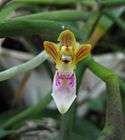Cleisostoma simondii
| Cleisostoma simondii | |
|---|---|
_-_Bot._Reg._8_pl._676_(1822).jpg) | |
| 1822 illustration from Botanical Register | |
| Scientific classification | |
| Kingdom: | Plantae |
| (unranked): | Angiosperms |
| (unranked): | Monocots |
| Order: | Asparagales |
| Family: | Orchidaceae |
| Subfamily: | Epidendroideae |
| Tribe: | Vandeae |
| Subtribe: | Sarcanthinae |
| Genus: | Cleisostoma |
| Species: | C. simondii |
| Binomial name | |
| Cleisostoma simondii (Gagnep.) Seidenf. (1975) | |
| Synonyms[1][2] | |
| |
Cleisostoma simondii is a flowering plant that grows upon larger trees, and known in Hong Kong as (Chinese:蜘蛛蘭). It also occurs in the Himalayas (Nepal, Bhutan, India, Assam), Cambodia, Laos, Myanmar, Thailand, Vietnam, and other parts of China (Fujian, Guangdong, Hainan, Yunnan).[1][3]
Etymology
The name "Cleisostoma" derives from the Greek words kleistos, meaning "closed" and "stoma" meaning "mouth".[4]
Description
Cleisostoma simondii grows to a length of 30–40 centimetres (12–16 in) or more, with numerous aerial roots that grow out of the stems. This hardy orchid grows thin, stem-like jointed leaves 10–28 centimetres (3.9–11.0 in) long that are fleshy, terete, linear year round, with the whole plant colors ranging from green to dark green under humid, low light conditions, to red to purple under drier more sunlit conditions. The flowers buds develop in late September, blooming long-lasting flowers from October to early November, on a spike up to 10–15 centimetres (3.9–5.9 in) long, composed from one to eleven flowers, averaging six to seven flowers, with each flower averaging 1.5 cm (15mm) in diameter.[3] [5][6][7]
Varieties
Two varieties are recognized:[1]
- Cleisostoma simondii var. guangdongense Z.H.Tsi - Fujian, S Guangdong, Hainan
- Cleisostoma simondii var. simondii - Yunnan, Himalayas (Nepal, Bhutan, India, Assam), Cambodia, Laos, Myanmar, Thailand, Vietnam
Gallery
-

Cleisostoma simondii Orchid Flowers up close.
-

Cleisostoma simondii Orchid flowering.
-

Cleisostoma simondii Orchids growing wild in a massive Clonal colony in Hong Kong, China.
-

A group of wild Cleisostoma simondii Orchids flowering in a tree branch in Hong Kong.
References
- 1 2 3 Kew World Checklist of Selected Plant Families, Cleisostoma simondii
- ↑ Kew World Checklist of Selected Plant Families, Cleisostoma simondii var. simondii
- 1 2 Flora of China, v 25 p 463, 毛柱隔距兰 mao zhu ge ju lan, Cleisostoma simondii
- ↑ https://lab.troymeyers.com/flasking/item.php?kind=flask&id=TN6092
- ↑ http://www.fotop.net/hkwildorchid/Cle_sim_var_gua
- ↑ http://www.orchidspecies.com/cleissimondii.htm
- ↑ http://exoticbulbophyllum.tripod.com/cleisostoma/Cleisostoma_simondii.htm